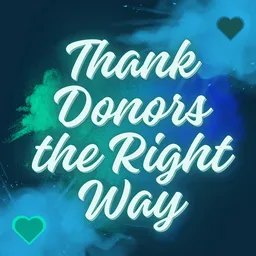When someone donates to your organization, they do more than write a check—they invest in your mission, values, and vision. A thank-you note isn’t just a formality; it’s a powerful opportunity to build trust, deepen relationships, and inspire continued support. When done thoughtfully, a simple expression of gratitude can turn a one-time gift into a long-term partnership.
Here’s how to thank donors correctly so they feel appreciated and inspired to stay connected.
1. Say Thank You Quickly
Timing matters. The sooner you express gratitude, the more meaningful it feels. Aim to thank donors within 48 hours of receiving their gift—whether online, by check, or in person. A prompt response shows that their contribution is valued and recognized.
Automation can help with email receipts, but don’t stop there. Personal touches (we’ll get to that in a moment) elevate a basic thank-you into something memorable.
2. Personalize Your Message
No one wants to feel like just another name in a database. The best thank-you notes use the donor’s name, mention the amount or type of gift (e.g., one-time, recurring, in-kind), and acknowledge why it matters.
For example:
Dear Alex, Your $100 gift is already helping
students access safe, reliable transportation
to school. Your support is changing lives.
Thank you.Even better? Mention how long they’ve been giving or refer to a specific campaign they contributed to. It shows you’re paying attention.
3. Use Multiple Channels
Don’t limit yourself to just one thank-you method. Mix it up with:
- Email thank-yous: Immediate, easy, and significant for receipts.
- Handwritten notes: Personal and impactful, especially for new or recurring donors.
- Phone calls: Particularly meaningful for major donors or long-time supporters.
- Video thank-yous: Short videos from staff, students, or beneficiaries can feel heartfelt and personal.
Please choose the format based on the gift level and your capacity, but remember: people remember how you make them feel, and nothing beats a personal touch.
4. Highlight the Impact
Gratitude is powerful, but impact is what makes it stick. Show donors how their gift made a difference. Did their contribution fund a new program? Feed 100 families? Provide art supplies to a classroom?
Whenever possible, include stories, images, or testimonials. A photo of a smiling student or a note from a family helped by your services speaks louder than statistics alone.
5. Recognize Them Publicly (If They’re Comfortable)
Many donors appreciate being publicly acknowledged for their support. Consider listing donors in your newsletter, annual report, social media, or on a donor wall. Just ask permission—some prefer to stay behind the scenes.
Recognition reinforces their value to your community and may inspire others to give.
6. Keep Saying Thank You—Not Just After a Gift
Gratitude shouldn’t stop after the donation is received. Continue to show appreciation throughout the year:
- Send a thank-you during the holidays.
- Celebrate the anniversary of their first donation.
- Invite them to events, not just fundraisers.
- Share progress updates with a tone of appreciation.
Donors who feel consistently seen and valued are far more likely to remain long-term partners.
7. Make it Authentic
Above all else, keep your thank-you authentic. Avoid overly formal or generic language. Be warm, honest, and human. Even if you’re using a template, leave room to tailor the tone and content to reflect your organization’s personality and the donor’s unique support.
Final Thoughts
Saying “thank you” the right way goes far beyond good manners—it’s the foundation of lasting donor relationships. When your appreciation feels timely, genuine, and connected to impact, your donors feel like they’re part of something bigger and’ll want to keep showing up.
So make it personal, heartfelt, and most importantly, meaningful.
